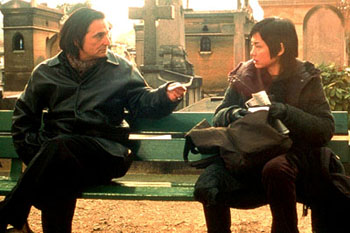![[Metroactive Movies]](/movies/gifs/movies468.gif)
[ Movies Index | Show Times | Silicon Valley | Metroactive Home | Archives ]
Keeping Watches
Meanings multiply to no end in 'What Time Is It There?'
By Richard von Busack
CUTENESS AND AUSTERITY make strange bedfellows. In post-Wong Kar-wei Asian films, however, it's common to see brokenhearted, blocked souls acting as quirky as silent-movie comedians. In Kar-wei's Chungking Express, there's a celebrated passage about a lovelorn cop feeding himself about five gallons of canned pineapple in one sitting. The scene could be read as an anti-joke, a touching incident of a lonely man counteracting emotional pain by doing something physically painful, or as a piece of atmospheric poetry related to the expiration date of his romance, or even as an allusion to the expiration date of Hong Kong as an independent city. All of these are reasons for the marathon pineapple gorging, and yet none quite explains why he's forcing down all that sticky, syrupy fruit.
What Time Is It There? by Taiwan's Tsai Ming-liang offers a similar study in compulsive behavior. The hero, Hsiao-kang (Lee Kang-sheng), apparently the loneliest man in Taipei, sets clocks back seven hours. The gesture has two possible explanations: he's grieving for his father and wants to turn back the hands of time to when the old man was alive, or he's sending a secret message to a girl (Chen Shiang-chyi) he's met twice who is currently in Paris seven time zones away. Kar-wei's style of filmmaking is for people keen to guess. While these works are so sensitive you feel like a heel for asking practical questions, you're still given much time to consider what it is that troubles these characters and why they're exhibiting such peculiar behaviors.
The model for the film's remoteness is the French New Wave and its precise static studies of alienation. Director Ming-liang has loaded his film with references to The 400 Blows and included a cameo by Jean-Pierre Léaud. The clips we see of Truffaut's film are fluid and vital; What Time Is It Now? is so desiccated and cryptic that you long to stay with the old movie instead of the new one.
Parallels between Hsiao-kang's daily life and Shiang-chyi's character's trip to Paris heighten the mood of depression. She has the most anhedonic vacation in movie history, experiencing first indifference, then romantic rejection. This is a Paris of dingy subway stations and cheap, thin-walled tourist hotels. Through nothing stronger than the power of juxtaposition, we're led to guess that these two mopes would be happier together. As in Kar-wei's films, the only perfect love is unrequited. Any ex-adolescent will sympathize with that view. Anyone who got over it may wish for something more substantial.
What Time Is It There? is a delicate film, but it's also a boring one. The studied social/sexual critique in the French films is replaced here by characters pining for romantic love as an escape from blood-freezing cities. The pursuit of love can be a dead-end in itself. This pursuit can be an empty as the aimless rituals in What Time Is It There?: the turning back of clocks, the placation of a dead man's spirit. It's not necessarily more profound than making a simpler movie--it's just definitely a lot less fun.
[ Silicon Valley | Metroactive Home | Archives ]
Copyright © Metro Publishing Inc. Metroactive is affiliated with the Boulevards Network.
For more information about the San Jose/Silicon Valley area, visit sanjose.com.
![]()

What's Old Is New Wave Again: Truffaut star Jean-Pierre Léaud meets Chen Shiang-chyi in 'What Time Is It There?"
What Time Is It There? (R; 116 min.), directed by Tsai Ming-liang, written by Yang Pei-ying and Ming-liang, photographed by Benoît Delhomme and starring Lee Kang-sheng and Chen Shiang-chyi, opens Friday at the Towne Theater in San Jose.
From the January 31-February 6, 2002 issue of Metro, Silicon Valley's Weekly Newspaper.